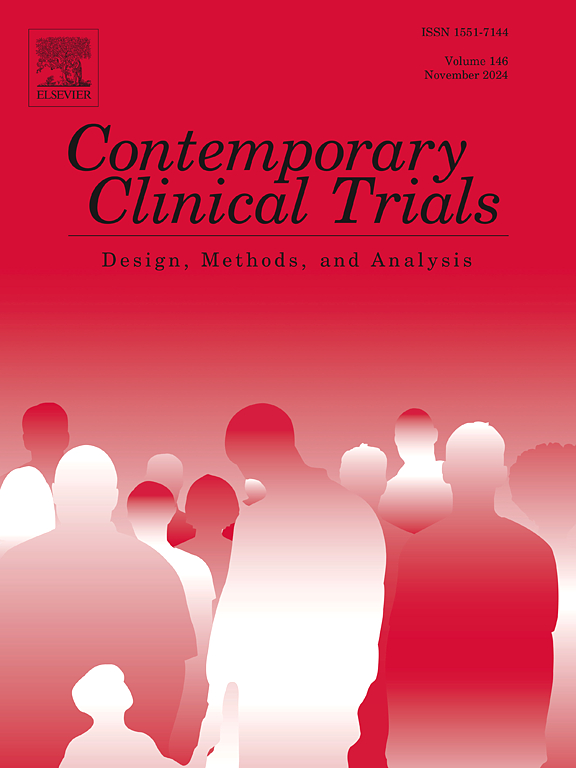拆除开放标签安慰剂及其原理:远程四组随机对照试验协议。
IF 1.9
3区 医学
Q3 MEDICINE, RESEARCH & EXPERIMENTAL
引用次数: 0
摘要
目的:探讨基本原理对安慰剂的影响,这些安慰剂被诚实地描述为无活性药丸(开放标签安慰剂;OLPs)对慢性疼痛的影响。设计:拆解四组随机对照试验。环境:与美国居民进行远程研究。研究对象:年龄18 ~ 89岁的慢性疼痛患者。方法:我们计划招募340名受试者,在同意前随机化(Zelen随机化程序)分为4组。无治疗组的参与者将不接受任何olp。三个OLP组的参与者将被告知每天服用两次OLP药片,持续21 天。参与者得到的关于安慰剂的信息会有所不同。“标准OLP”组的患者将获得与先前OLP试验相似的基本原理。那些在“正念- olp”组将提供一个理由采取正念方法。“控制- olp”组(和无治疗组)将提供长度匹配的疼痛人口统计信息;不提供安慰剂信息。这种拆解设计将允许我们比较基本原理(标准- olp vs正念- olp),并检查基本原理效应(标准- olp或正念- olp vs对照- olp),安慰剂效应(标准- olp或正念- olp vs无治疗)和药丸效应(对照- olp vs无治疗)。疼痛强度超过42 天是主要结果。结论:本试验将研究olp的不同成分如何影响慢性疼痛人群的疼痛。我们还强调了解决先前OLP研究局限性的新方法;即缺乏盲法和控制不当。本文章由计算机程序翻译,如有差异,请以英文原文为准。
Dismantling open-label placebos and their rationales: A remote 4-arm randomized controlled trial protocol
Objective
To explore the effect of rationales on placebos described honestly as inactive pills, (open-label placebos; OLPs) on chronic pain.
Design
Dismantling 4-arm randomized controlled trial.
Setting
Remote study with United-States residents.
Subjects
Chronic pain patients aged 18 to 89.
Methods
We plan to recruit 340 subjects, randomized before consent (Zelen randomization procedure) into one of 4 groups. Participants in a no-treatment group will not receive any OLPs. Participants in the three OLP groups will be told to take an OLP pill twice daily for 21 days. The information participants are given about placebos will vary. Those in the “Standard-OLP” group will be provided with a rationale similar to those used in prior OLP trials. Those in the “Mindfulness-OLP” group will be provided with a rationale taking a mindfulness approach. Those in the “Control-OLP” group (and no-treatment group) will be provided with length-matched information about pain demographics; no placebo information will be given. This dismantling design will allow us to compare rationales (Standard-OLP vs Mindfulness-OLP), and examine the rationale effect (Standard-OLP or Mindfulness-OLP vs. Control-OLP), the placebo effect (Standard-OLP or Mindfulness-OLP vs. No-treatment), and the pill effect (Control-OLP vs no-treatment). Pain intensity over 42 days is the primary outcome.
Conclusions
This trial will investigate how different components of OLPs impact pain among a chronic pain population. We also highlight novel ways to address limitations of prior OLP studies; namely, lack of blinding and improper controls.
求助全文
通过发布文献求助,成功后即可免费获取论文全文。
去求助
来源期刊
CiteScore
3.70
自引率
4.50%
发文量
281
审稿时长
44 days
期刊介绍:
Contemporary Clinical Trials is an international peer reviewed journal that publishes manuscripts pertaining to all aspects of clinical trials, including, but not limited to, design, conduct, analysis, regulation and ethics. Manuscripts submitted should appeal to a readership drawn from disciplines including medicine, biostatistics, epidemiology, computer science, management science, behavioural science, pharmaceutical science, and bioethics. Full-length papers and short communications not exceeding 1,500 words, as well as systemic reviews of clinical trials and methodologies will be published. Perspectives/commentaries on current issues and the impact of clinical trials on the practice of medicine and health policy are also welcome.

 求助内容:
求助内容: 应助结果提醒方式:
应助结果提醒方式:


